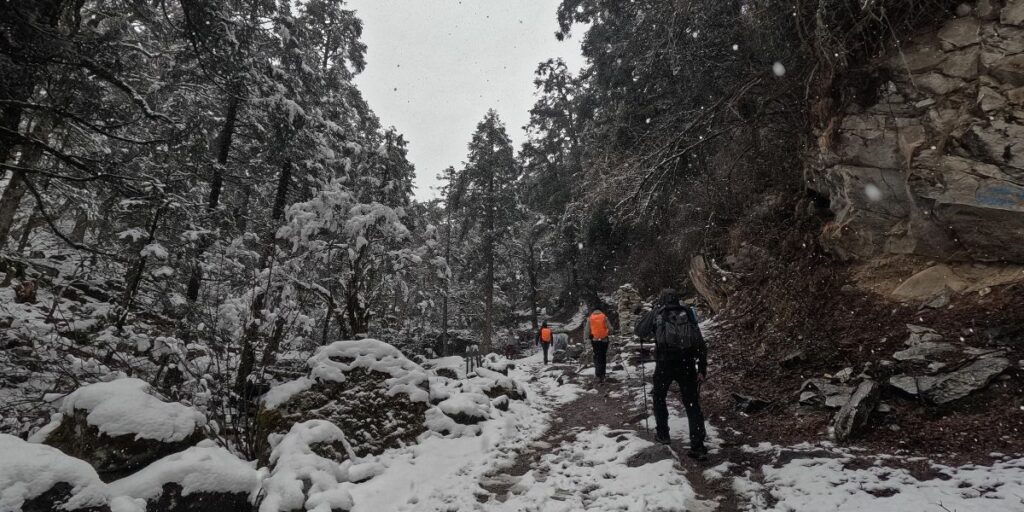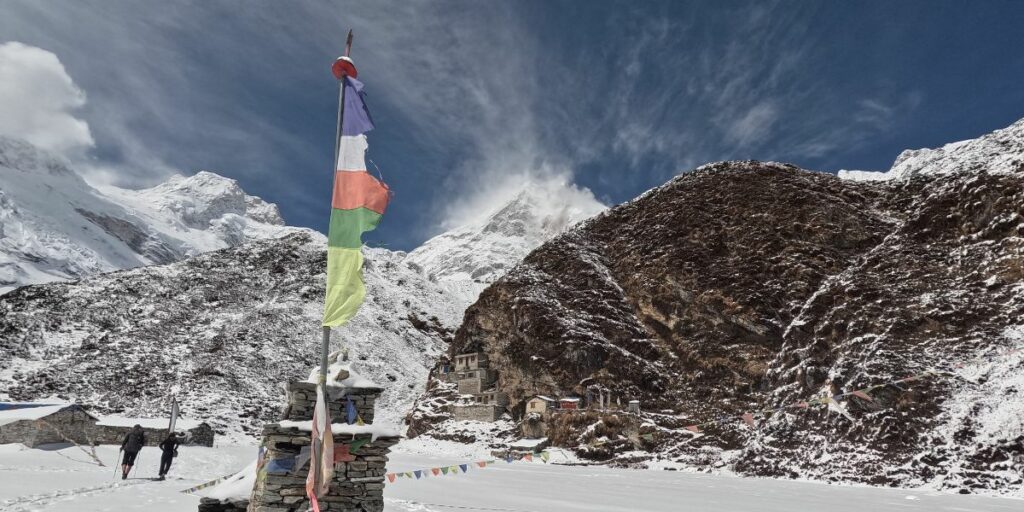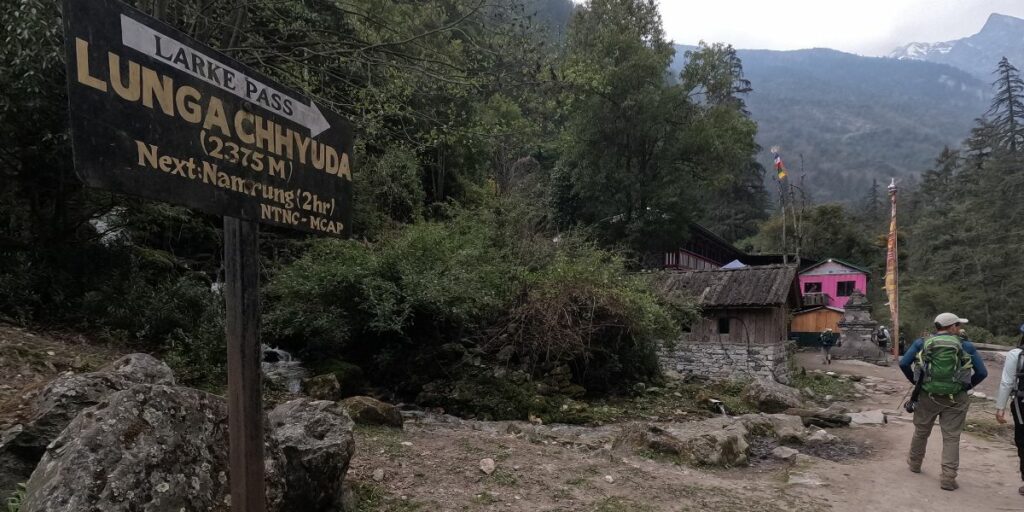How Much Does It Cost to Trek the Manaslu Circuit? 2025/26
The Manaslu Circuit Trek has emerged as one of Nepal’s most spectacular yet relatively uncrowded trekking experiences. Often hailed as a spectacular yet less crowded alternative to the famed Annapurna Circuit, the Manaslu region offers breathtaking vistas and a unique cultural experience. You may still worry about “ How much does it cost to trek the Manaslu Circuit?”. In 2025, the total cost to trek the Manaslu Circuit typically ranges between $900 and $2,500 USD per person for a 14–16 day itinerary. This range covers everything from permits, transportation, accommodation, and meals to optional guide and porter services. The final cost depends on your trekking style, whether you choose a budget-friendly independent trek with a guide or a more luxurious full-service package.
Discovering the Manaslu Circuit: What to Expect
Before diving into the budget, it is essential to understand what makes the Manaslu Circuit Trek a unique and challenging journey through Nepal’s remote mountains. This trek takes you through one of Nepal’s most remote and culturally rich regions, circling the majestic Mount Manaslu, the eighth-highest mountain in the world.
What Makes the Manaslu Circuit Special?
The Manaslu Circuit Trek winds through remote villages in the Gorkha district of Nepal, encircling Mount Manaslu (8,163m). This restricted-area trek spans approximately 177 kilometers, crossing the challenging Larkya La Pass (5,160m) and connecting to the popular Annapurna Circuit at Dharapani.
Most trekkers complete the journey in 14-16 days, though itineraries can be adjusted based on acclimatization needs and trekking pace. The Manaslu Circuit is considered a moderately difficult trek that requires good physical fitness, as you’ll be walking 5-7 hours daily with significant elevation gains.
Best Time to Trek (and How It Affects Cost)
The best seasons for the Manaslu Circuit are October-November (autumn) and March-May (spring), offering stable weather and clear mountain views.
- Spring (March-May): Clear mornings with occasional afternoon clouds, blooming rhododendrons, and moderate temperatures.
- Autumn (October-November): The most popular season offering stable weather, clear skies, and excellent mountain views.
These peak seasons come with higher costs:
- Teahouse rates increase by 20-30%.
- Guide and porter fees rise by 10-15%.
- Transportation costs may increase due to higher demand.
Trekking during off-peak seasons (December-February and June-September) can reduce your costs by 15-25%, but comes with different challenges. It includes monsoon raus, leeches, or winter cold and snow-blocked passes. The cost savings should be weighed against these potential difficulties.
Factors that Affect the Cost of the Manaslu Circuit

Essential Permits and Their Costs
A special restricted area permit is also required for the Manaslu Circuit Trek. When you understand the price of the permit, it will ensure your easy trek. As a restricted area trek, the region requires several permits, representing a significant portion of your budget:
- Manaslu Restricted Area Permit (MRAP)
- Peak season (Sep-Nov & Mar-May): $100 for the first 7 days + $15 per additional day
- Off-season (Dec-Feb & Jun-Aug): $75 for the first 7 days + $10 per additional day
- Manaslu Conservation Area Permit (MCAP)
- Cost: NPR 3,000 (approximately $25)
- Annapurna Conservation Area Permit (ACAP)
- Required as the trek exits through the Annapurna region
- Cost: NPR 3,000 (approximately $25)
- TIMS Card (Trekkers’ Information Management System)
- Individual trekkers: NPR 2,000 (approximately $16)
- Group trekkers (through an agency): NPR 1,000 (approximately $8)
For Nepali Trekkers: Nepali citizens pay significantly reduced rates for all permits. The Manaslu Restricted Area Permit costs approximately NPR 1,000, while conservation area permits are around NPR 100-300.
Total Manaslu Circuit permit costs for international trekkers: $150-200, depending on season and trek duration.
How to Obtain Permits?
Manaslu Circuit permits cannot be obtained individually – you must go through a registered Nepali trekking agency. This regulation was implemented to ensure trekker safety in this remote region. Required documentation includes:
- A passport with at least 6 months’ validity
- Passport-sized photographs (4-6 copies)
- Travel insurance details
Permits are typically arranged 2-3 days before starting the trek, though booking through an agency well in advance is recommended, especially during peak seasons.
Transportation Costs
Getting to and from the Manaslu Circuit Trek requires careful planning, as the region is remote and road access is limited. Your journey will start from Kathmandu and head toward Soti Khola or Machha Khola, small trailhead villages where the trek begins. On the return, most routes conclude in Dharapani or Besisahar, which offer further connections back to Kathmandu. Depending on your budget and comfort preferences, you can choose between public buses or private jeeps that cost you differently.
Getting to the Starting Point
The Manaslu Circuit typically begins in Soti Khola or Machha Khola, both reachable by road from Kathmandu. Trekkers can choose from the following transportation options:
- Private Jeep: $150–$200 (total, shared among 5–7 trekkers)
- Journey time: 8–9 hours
- Offers more comfort, flexibility, and better handling on rough roads.
- Public Bus: $10–$15 per person
- Journey time: 10–12 hours
- A budget-friendly option, though less comfortable and often crowded.
Return Transportation
The trek usually ends in Dharapani or Besisahar, from where you’ll need transportation back to Kathmandu. Here are your options:
- Jeep from Dharapani to Besisahar: USD 200-250 per vehicle for up to 7 people( private jeep)
- Bus from Besisahar to Kathmandu: $8–$12 per person( tourist bus)
- Private vehicle from Besisahar to Kathmandu: $100 to $300 USD ( exact cost may vary)
Estimated Total Round-Trip Cost:
- Public/shared transport: $25–$70 per person
- Private vehicles (door-to-door): $250–$350
These return options offer varying levels of comfort and speed. If time is tight or you’re traveling with a group, a private vehicle may be worth the extra cost.
Guide and Porter Fees
You may be curious whether to hire a guide or not. But as it is a restricted region, trekking the Manaslu Circuit without a guide is prohibited. You must hire at least a licensed guide, though many trekkers opt for both a guide and a porter.
Guide Fees: $25-35 per day
- Experienced, English-speaking guides: $30-40 per day
- Expect to pay higher rates during peak season
- For a 15-day trek: $375-525 total
A good guide provides cultural insights, handles logistics, communicates with locals, ensures safety, and manages emergencies. This is not an area to cut costs, as your guide significantly enhances the trekking experience.
Porter Services and Rates
While not mandatory, porters make the trek more enjoyable by carrying your heavy gear:
Porter Fees: $18-25 per day
- For a 15-day trek: $270-375 total
- Each porter typically carries up to 15-20kg (two trekkers’ gear)
- Porter-guides (who both carry and guide): $28-35 per day
Cost-sharing options:
- Two trekkers can share one porter, essentially halving this cost.
- Groups of 4+ can optimize with a combination of porters and guides.
Remember to budget for tips: 10-15% of the total guide/porter fee is customary for good service.
Accommodation Costs Along the Trek
One of the most convenient aspects of trekking the Manaslu Circuit is the widespread availability of teahouses. These are the primary accommodation option along the trail and can be found in nearly every village, making them a reliable choice for both budget and flexible travelers. The Manaslu Circuit is dotted with basic teahouses (lodges) that provide accommodation for trekkers:
- Lower elevation (Soti Khola to Namrung): $3-8 per night
- Mid-elevation (Lho to Samdo): $5-10 per night
- High elevation (Dharmashala/Larkya Phedi): $8-15 per night
Factors affecting room rates:
- Attached bathrooms (add $3-5)
- Room heating (add $3-5)
- Seasonal variations (peak season prices are 20-30% higher)
Most teahouses operate on the understanding that guests will eat meals at their accommodation. Some may offer free accommodation if you commit to meals there.
Food and Dining Expenses
Food costs on the Manaslu Circuit gradually increase as you gain altitude, primarily due to the logistical challenge of transporting ingredients to remote mountain villages. At lower elevations, you can expect to spend around $15–20 per day, which typically covers three meals and some light snacks. As you ascend to higher, more isolated areas, this daily food budget can rise to $20–30.
Sample meal costs:
- Breakfast (porridge, eggs, bread): $3-6
- Lunch or dinner (dal bhat, noodles, fried rice): $5-10
- Hot drinks (tea, coffee): $1-3
- Snacks (chocolate bars, energy drinks): $2-5
Budget-friendly tips:
- Dal bhat (Nepali rice, lentils, and vegetables) often comes with free refills
- Vegetarian options are typically cheaper
- Stick to local food instead of Western dishes
Total daily accommodation and food costs: $20-45, depending on elevation and personal choices.
Additional Expenses to Consider

Besides the basics, several small (but important) costs can add up. Smart budgeting will ensure you’re not caught off guard. Beyond the major costs of permits, transportation, guide/porter fees, accommodation, and food, several other expenses can impact your total Manaslu Circuit Trek cost.
Gears and Equipment Rental or Purchase
You will need appropriate trekking gear, including sturdy hiking boots, warm layers, a waterproof jacket and trousers, a sleeping bag (suitable for sub-zero temperatures), a down jacket, a headlamp, sunglasses, sunscreen, and a basic first-aid kit. Purchasing all this gear can be expensive, so you can either rent it in Kathmandu. Kathmandu has numerous shops in areas like Thamel that rent out trekking equipment at reasonable prices. Daily rental costs for items like sleeping bags and down jackets typically range from USD 1 to USD 3.
What’s Worth Buying vs. Renting?
It’s generally recommended to buy your own comfortable and well-fitting hiking boots, as blisters can ruin your trek. It is also advised to invest in a good quality socks. Renting items like sleeping bags, down jackets, and trekking poles can save money if you don’t plan to trek frequently. However, ensure rented gear is in good condition before you leave Kathmandu.
Travel Insurance
Travel insurance is essential and highly recommended for the Manaslu Circuit. Your policy must cover high-altitude trekking, specifically up to 5,200 meters, as this is the maximum elevation reached on the Manaslu Circuit at Larkya La Pass. Medical evacuation and emergency rescue (including helicopter evacuation) must be included, as the nearest major hospital may be hours away. In case of altitude sickness, injuries, or severe illness, evacuation is often the only safe option. The cost typically ranges from USD 50–150, depending on the provider, duration, and level of coverage. Always read the fine print and keep digital and hard copies of your policy and emergency contact numbers accessible during your trek.
Miscellaneous Costs
Some teahouses along the Manaslu Circuit offer Wi-Fi, but it usually comes at an extra cost. Similarly, Hot showers are not always available, especially at higher altitudes. But they will charge certain prices where it is available. Don’t forget these additional expenses:
- Wi-Fi: $3-5 per device at lower elevations, $5-10 at higher points
- Battery charging: $2-5 per device
- Hot showers: $3-7 (available up to Samagaun, rare beyond that)
- Bottled water: $1.50-4 per liter (increasing with altitude)
- Emergency fund: $200-300 recommended
Package Tours vs. Independent Trekking

Given the restricted area status of the Manaslu region, independent trekking in the sense of not having a guide is not permitted. However, you can still choose between an all-inclusive package tour organized by an agency or arranging certain aspects (like transportation to and from the trailhead) yourself while still hiring a guide and potentially porters through an agency.
Mountain Routes provides different packages for the Manaslu region. From a single Manaslu circuit trek with a combination of Tsum Valley, an amazing experience awaits you.
| Trek Package | Total Cost(per person) | Duration | Possible Highlights |
| Manaslu Circuit Trek | USD 1575 | 16 Days | Larke Pass, remote villages, Tibetan culture |
| Tsum Valley Trek | USD 1785 | 19 Days | Sacred Tsum Valley, traditional villages, ancient Buddhist heritage |
| Manaslu Circuit with Tsum Valley Trek | USD 1850 | 22 Days | Tsum Valley monasteries, Mu Gompa, cultural exploration |
Budget for Independent Trekkers
While fully independent trekking is not permitted in the Manaslu Restricted Area for foreign nationals, understanding the potential daily costs can be helpful. If you were to manage accommodation and food independently, your daily expenses could range from USD 25 to USD 50, excluding permits and transportation. However, given the regulations, this scenario is not a practical option for most. Nepali citizens undertaking the trek might have a lower Manaslu Trek cost as they are exempt from the RAP and might have different rates for other services. However, they would still need to budget for transportation, accommodation, food, and potentially a guide or porter if desired.
Sample Manaslu Circuit Trek Cost Breakdown for 2025/26
To provide a clearer picture, here are estimated cost breakdowns for different budget levels for a typical 14- 16-day Manaslu Circuit trek for a foreign national:
| Expense Category | Budget Option (USD 1,200 – 1,500) | Standard Option (USD 1,800 – 2,200) | Comfort Option (USD 2,500 – 3,500+) |
| Permits | USD 120 – 145 | USD 120 – 145 | USD 120 – 145 |
| Transport (to/from) | USD 35 – 55 | USD 120 – 152 | USD 330 – 450 |
| Guide | USD 420 (USD 30/day) | USD 560 (USD 40/day) | USD 700 (USD 50/day) |
| Porter | – | USD 163 (shared, USD 25/day) | USD 390 (dedicated, USD 30/day) |
| Accommodation | USD 91 (USD 7/night) | USD 130 (USD 10/night) | USD 195 (USD 15/night) |
| Food | USD 350 (USD 25/day) | USD 420 (USD 30/day) | USD 490 (USD 35/day) |
| Miscellaneous | USD 184 – 434 | USD 282 – 535 | USD 375 – 1125+ |
This is only the estimated Manaslu Circuit trek cost breakdown, the cost may vary according to your preferences and the trekking company yo choose.
Money-Saving Tips for the Manaslu Circuit
While the Manaslu Circuit requires certain mandatory expenses, there are ways to manage your Manaslu Circuit Trek cost effectively.
Pre-Trek Preparation for Manaslu Trek
- Bring essentials from home: Trekking gear is cheaper to purchase before arrival.
- Shop smart in Kathmandu: Negotiate prices, but focus on quality for critical items.
- Book with a mid-sized agency: They often offer better value than both large international companies and very small local operators.
- Travel during off-seasons: Early October or late November, early March or late May offer good weather with slightly reduced prices.
During the Circuit Trek
- Share porters with fellow trekkers.
- Carry water purification instead of buying bottled water.
- Try local dishes like dal bhat, often served with complimentary refills.
- Negotiate room rates when staying multiple nights.
- Minimize battery usage to reduce charging fees.
Plan your Manaslu Circuit Trek for 2026 with Mountain Routes
When asking “How much does it cost to trek the Manaslu Circuit?”, the answer ranges from $950 to 2,200, depending on your comfort preferences. For Nepali citizens, the Manaslu Trek cost for Nepali is significantly lower due to discounted permits and local pricing. For foreign trekkers, whether you’re aiming for a budget, standard, or luxury experience, the Manaslu Circuit Trek cost and itinerary by Mountain Routes offers amazing value for the money spent. With Mountain Routes, you can enjoy epic Himalayan vistas and cultural immersion, as well as challenging high-altitude passes; It’s a journey well worth the price. With the right planning and budget strategy, you can enjoy this off-the-beaten-path gem without breaking the bank. You can directly contact us for more details and a customized itinerary too.
FAQ
What is the total average cost of trekking the Manaslu Circuit?
The average cost ranges from USD 1,200 to USD 2,500+ per person, depending on your trekking style (budget, standard, or comfort), transportation choices, guide/porter fees, accommodation, and food preferences.
Are there any hidden costs I should be aware of on the Manaslu Circuit trek?
Yes, some common hidden costs include:
- Charging electronic devices and Wi-Fi (USD 1–5 each)
- Hot showers (USD 2–5)
- Snacks, bottled drinks, and souvenirs
- Extra accommodation/food due to delays
- Emergency transport or medical expenses (if uninsured)
Do I need to pay for my guide’s and porter’s food and accommodation?
When trekking with Mountain Routes, it is already included in your package, so you shouldn’t pay separately.
What currency should I bring to Nepal for the trek, and are there ATMs along the Manaslu Circuit?
Bring Nepali Rupees (NPR). ATMs are available in Kathmandu and Arughat, but not along the actual trekking route. Carry enough cash before you begin the trek.
Is travel insurance mandatory for the Manaslu Circuit trek, and what should it cover?
While not officially mandatory, comprehensive travel insurance is strongly recommended. It should cover:
- High-altitude trekking (above 5,000m)
- Emergency evacuation (helicopter rescue)
- Trip cancellation/interruption
- Medical expenses
Can I trek alone in the Manaslu Circuit trek?
No, solo trekking in the Manaslu Circuit is not allowed. As of recent regulations, you must trek with a licensed guide and in a group of at least two people (excluding the guide). Despite that solo trekking guide for Manaslu Circuit can be helpful for that.
Is the Manaslu Circuit cheaper than the Annapurna Circuit?
Not necessarily. The Manaslu Circuit can be slightly more expensive due to the requirement of a licensed guide, restricted area permits, and fewer accommodation options. Annapurna allows more flexibility and is more developed, making it easier to do budget-friendly solo treks.
